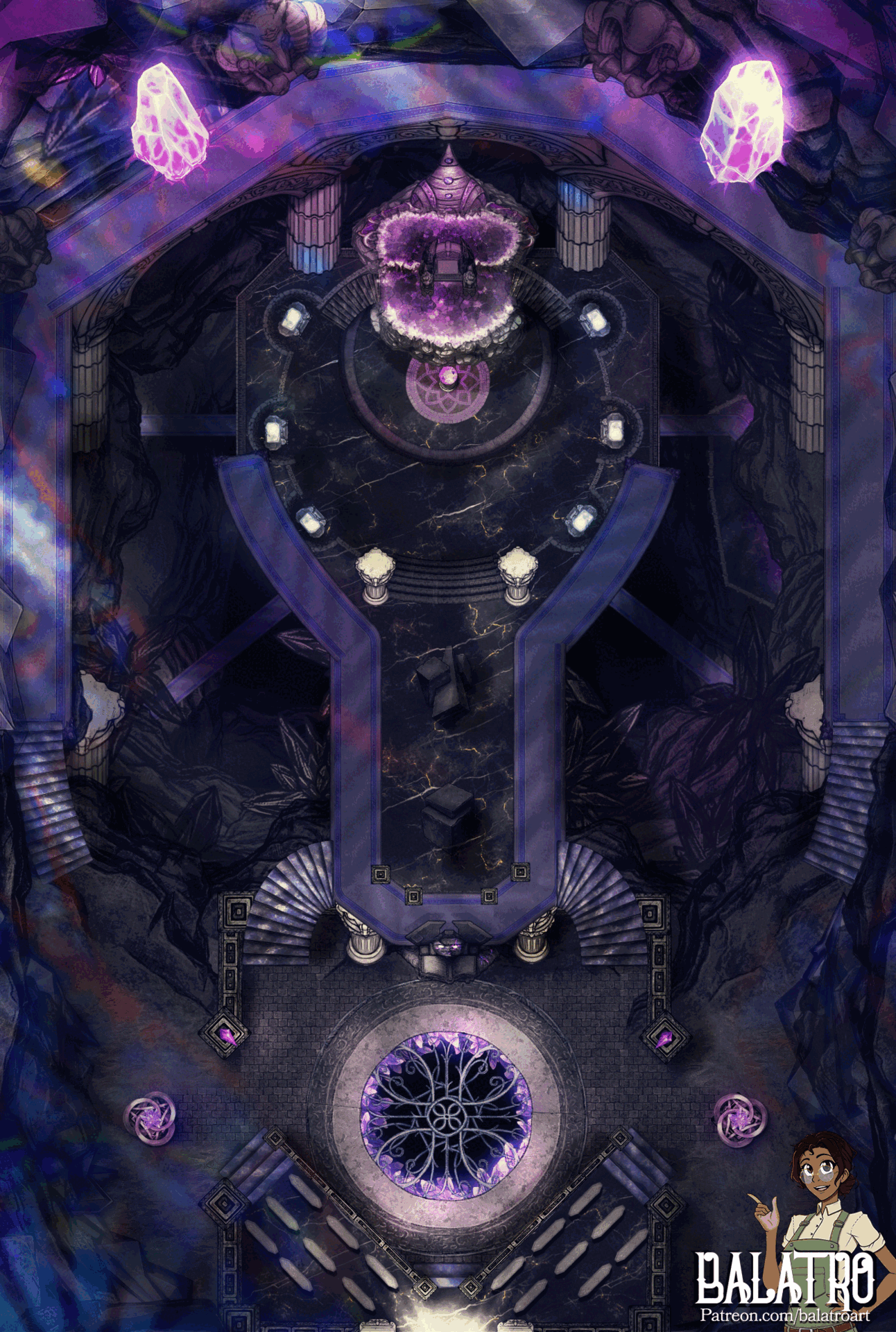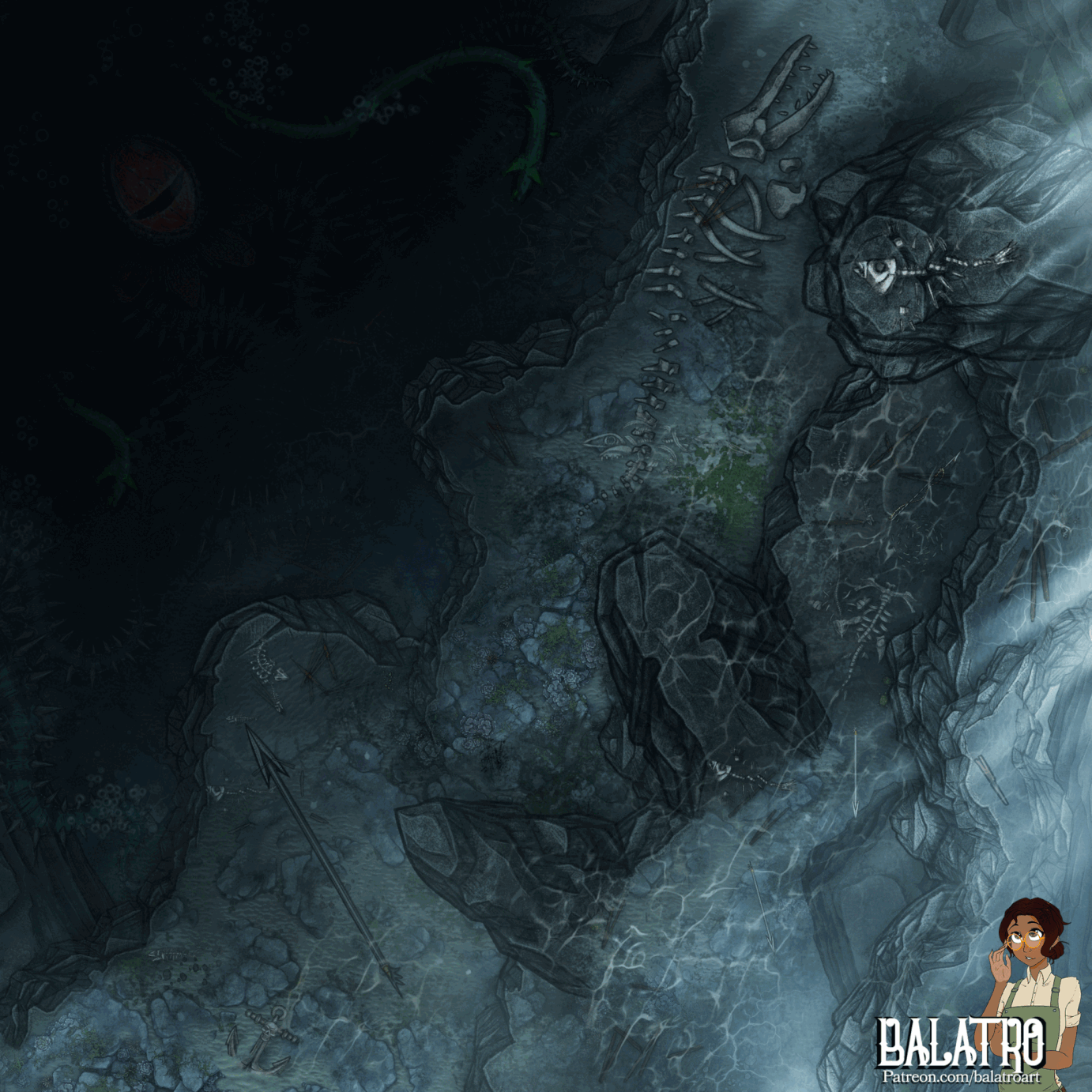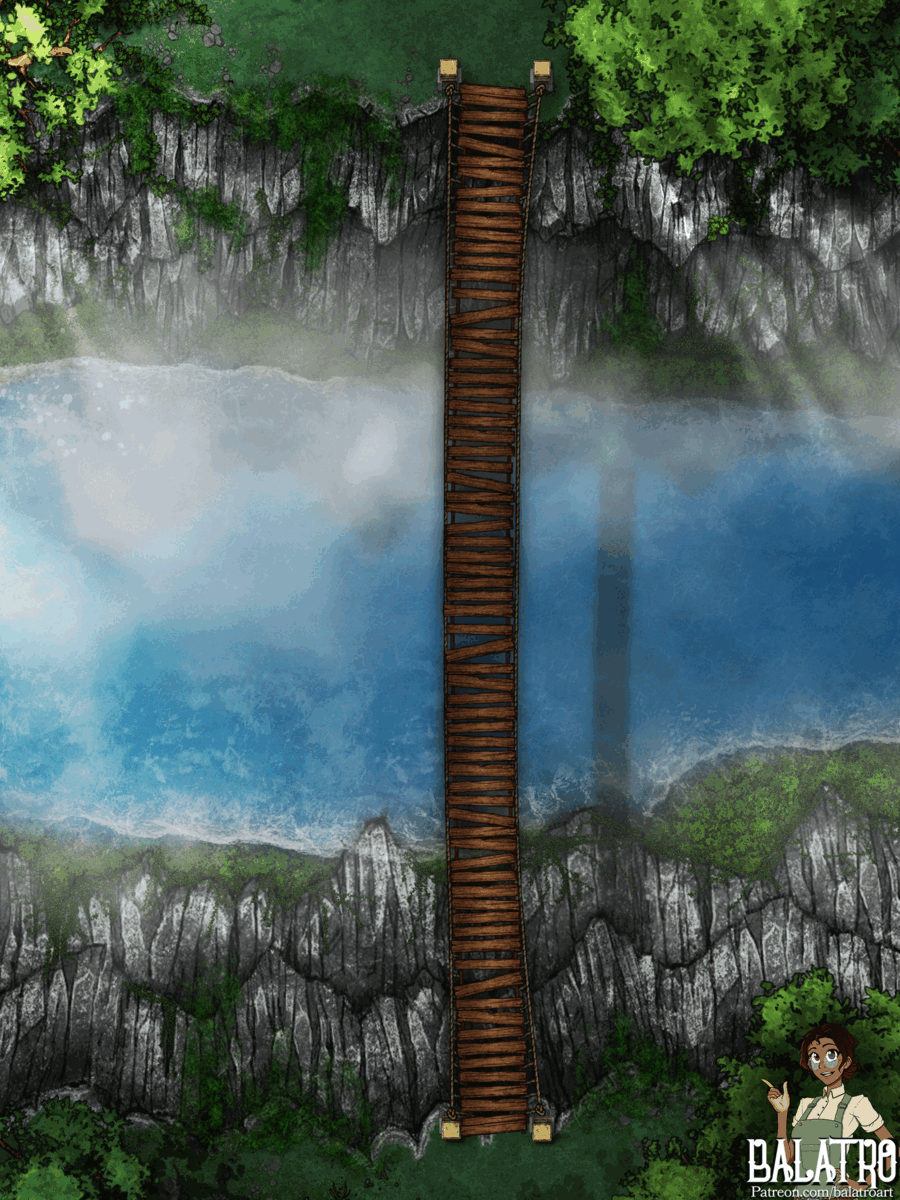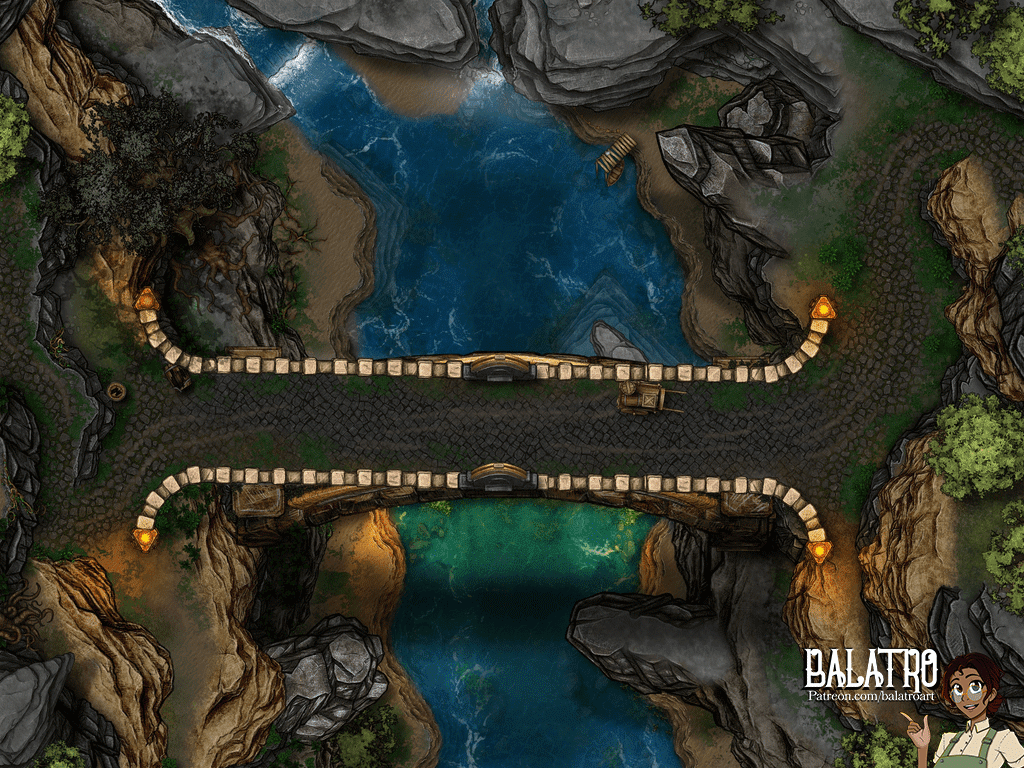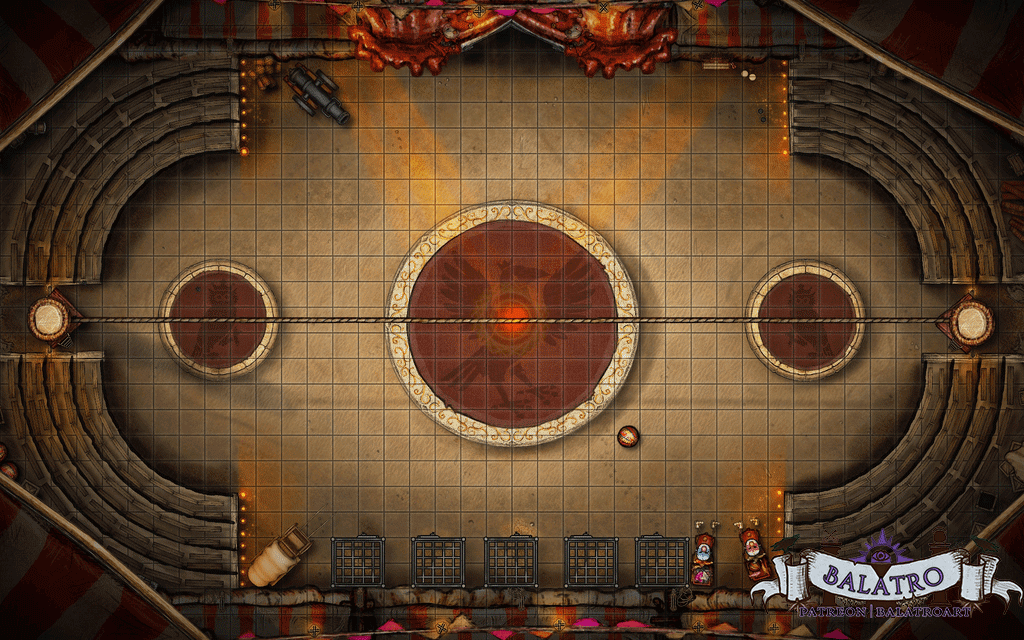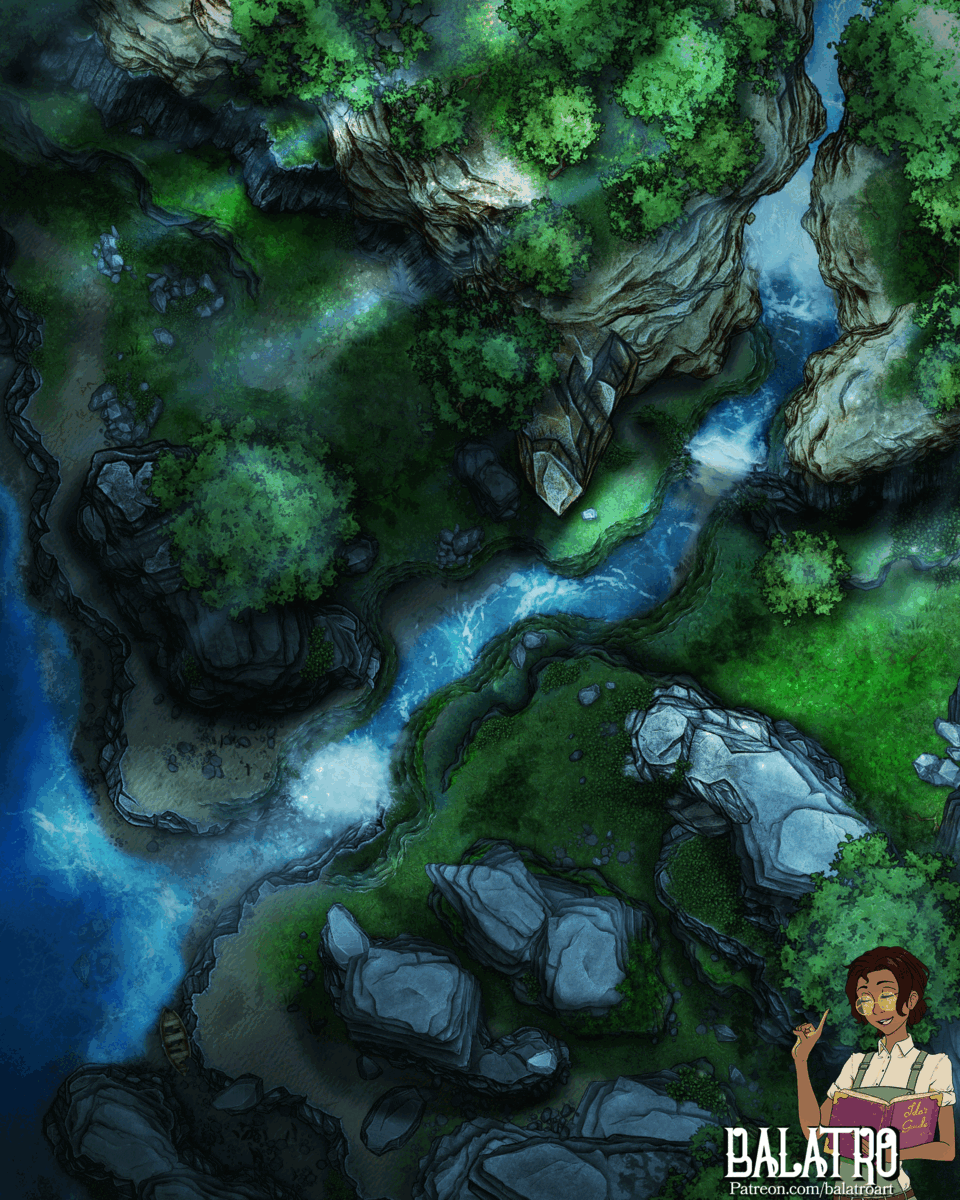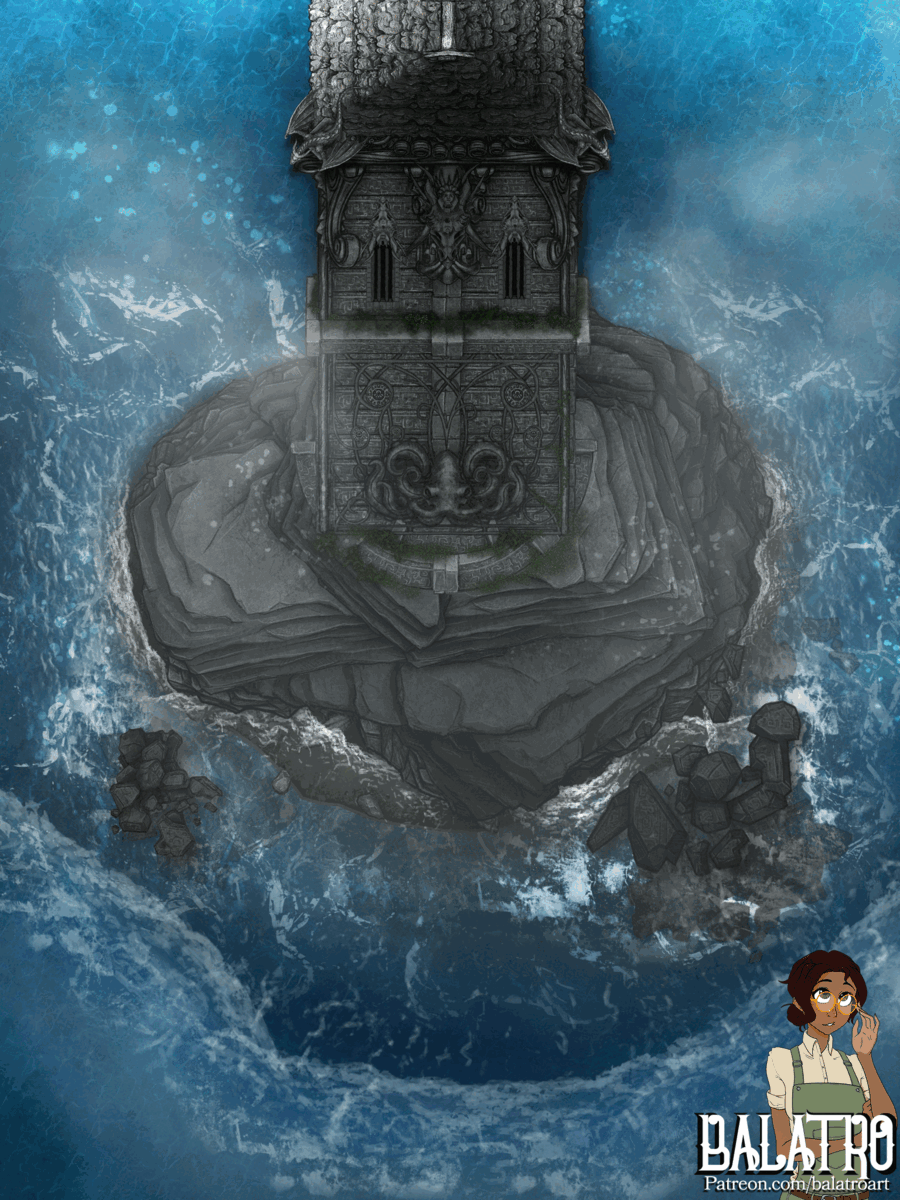
The Desimated lands of
Mimin-Akamora
In ages past, the realm was simply called Mimin, until the arrival of the winged serpent, Liki-Akamora, king of dragons. His reign was tyrannical and cruel, but nothing compared to the devastation that would follow after his subjects' failed attempt to depose him.
The destruction Akamora unleashed upon his homeland permanently altered its landscape, scarring the land and its people. Thousands of years of regrowth have passed, and only now, after centuries of healing, has this once desolate wasteland begun to recover from the horrors of its past. The land still bears the scars of Akamora's wrath, but with time, new life has emerged.
Battlemaps set in this location
Titan Stromatolite
These mountainous, layered, rock-like structures fill Mimin-Akamoras northern coastline. Formed by the slow accumulation of sediment and minerals trapped by colonies of tiny, invisible sea life. These living fossils may be the oldest evidence of life on Crudilex. Dating back to the first eras said to be the ancestors of the Atlantiens. Though they may appear as simple mounds or columns of stone, they are, in reality, the product of countless generations of invisible life.
The towering formations of ridged stone rise from the choppy sea, their surfaces rippled like the growth rings of a tree, yet far older than any forest in Crudilex. Their outer layers glisten with a thin sheen of brine, pulsing with hidden life. In the shallows, their bases stretch into labyrinthine tunnels, where the air is thick with the scent of salt and algae. Some claim these stones are not mere rock, but the fossilized remains of something still alive, something that remembers the first age of the world before the creation of time.
Patterwally: The Waking Carnival
Rare are the Mimsy settlements beyond the borders of Nocturne, the realm of dreams where they are created. If Patterwally is not the only one, it is certainly the largest and most well-known. At a glance, the city could easily be mistaken for a carnival with its colorful towers and vibrant, whimsical buildings. The streets are populated mostly by poppets—plush animals or ragdoll forms of Mimsy who have ventured beyond the realm of dreams.
Patterwally is the exception in the often gloomy lands of Mimin-Akamora, a city full of life where the rest of the country carries the sorrow of the land's history. In Patterwally, the Mimsy are ushering in a new, more optimistic era. The city is a unifying force for the fragmented factions that have endured in the wastelands, their survival driven by desperation. With the end of Mimin’s scarcity and the slow return of stability many see Patterwally as embodying the shift in Mimin-Akamora toward a more hopeful future.
Festivals, streets adorned with hanging rope lights that flicker like stars. Theaters, restaurants, dance halls, and music fill the air with celebration. Patterwally is in the middle of an artistic renaissance, with performers from all corners of Crudilex making the trek to the Mimsy city, seeking their future—and many may very well find it here.
Divwim of the Water Eicio
Home to the water Eicio, this port city is built among towering, craggy cliffs and choppy waters—the kind of place most sailors would dread. Yet, to any outsider’s surprise, its harbors and docks are filled with ships and boats, bursting with life. Unlike mostl cities, Divwim has few permanent structures. The majority of its people—the water Eicio and the seafaring orcs of the Galu nation—live aboard their personal boats and ships, forming a constantly shifting network of floating homes and businesses. Every necessity of city life is found among the houseboats moored in the harbor changing with the tides.
The one true landmark of Divwim, its most famous permanent fixture, looms high above the city on the rocky cliffs: The Tipsy Tavern. A haven for sailors, smugglers, and wanderers, this rickety old tavern is the only place where you can find a drink that won’t slosh with the rocking waves below—though after a night of revelry, the climb back down to the docks can be an adventure itself.
Tipsy Tavern
Perched high above the Divwim peninsula along the jagged bluffs, The Tipsy is a legendary sailor’s tavern and inn. A haven for wayfaring travelers navigating the western fjords, it serves as a crossroads where cultures from up and down the coasts of the triton sea converge. But with so many differing customs under one roof, tensions regularly flare. What one sailor considers an act of goodwill might be an insult to another. Brawls are common, with old grudges and drunken misunderstandings fueling the fire. The tavern gets its name for two reasons. First, it's always on the edge—both in reputation and in location. Second, and perhaps most famously, a 700-foot drop looms just beyond its doors, a sheer plunge into the churning waters below. Many a reckless patron has met their end that way, whether by misstep, bad luck, or the occasional helping hand.
“The Tipsy Tavern is a great place to hear a good tavern song. The best part, The clashing cultures sing the same song with the words slightly changed. Funny how a few shifted names can change a songs entire message.”
- Ida Holly
River of Omens
The river winds through the ruins of an ancient city, where once the mighty winged serpent Liki’Akamora ruled over all living things. Time and weather have worn the city down to smoothed stone, but scattered throughout the ruins, jade statues of the dragon’s army still stand—guardians whose duty has not waned in the thousands of years since their masters perished. On rare occasions, these silent sentinels stir to life, still following orders long since lost to history.
The city itself is little more than a ghost, picked clean and desecrated by the river’s flow. The people of Patterwallt believe it to be the best place to witness the rare and elusive Omenstags— for which the river takes its name.
Omen Stags
The glowing, antlered stags that seem to defy the very laws of physics, the Omenstags bound effortlessly through the air, covering impossible distances with grace. They move like specters, appearing only in fleeting glimpses before vanishing once more into the mists of the ruins. Many believe that merely laying eyes upon one is enough to bring a year of good fortune
Mahusha
At the western edge of Wish’s End is a vast stone bridge, mossy and overgrown, tended by the Mahusha, an order of Miminians sworn to protect the amethyst cathedral of Insitu and to ensure that no outsider come seeking the dead winged serpent, Liki-Akamora. Their oath binds them to keep the fallen dragon king dead for eternity, for fear that his influence might return to the world.
Despite this duty, the Mahusha are largely a peaceful cult, more widely recognized as the keepers of the only crossing west of Goblin Country. However, tensions have begun to rise between the Mahusha and Patterwally. Whispers spread that the tyrannical winged serpent has begun to appear in people’s dreams, and the Mahusha are convinced that the Mimsy, as personifications of dreams themselves, are somehow to blame. There are growing rumors that the Mahusha have sent spies into Patterwally, hoping to uncover the truth behind these disturbing visions.
Wishes End
A great chasm splits Minin-Akamora. It was here that the dragon king, Liki-Akamora, slew the Arch-Fey Wishdrake Kalt, leader of the Wishdrakes, who had sought to fulfill a wish rightfully earned by a mortal—to unmake the winged serpent tyrant himself.
But Liki’Akamora was no ordinary being. Too powerful to be slain in an instant, the Winged Serpent's very existence defied destruction. reality warped and bent, the fabric of the world twisting beneath the weight of the paradox. In a furious hunt that raged through the heavens and across the lands,
the Liki’Akamora pursued Kalt, as the wishdrake rewrote existence around them tearing through realms. At last, the final blow fell before the wish could be compleyely granted, and with it, something irrevocable shattered. The Book of Fate, which binds all that was, is, and will be, suffered a tear—an unnatural wound that the world itself recoiled from. The land cracked, rupturing apart, and when the dust settled, nothing remained but the Rift of Amethyst, a gaping void splitting the realm in two. Kalt, dead in Akamora’s screaming fangs.
This moment marked the true beginning of Liki-Akamora’s unchecked reign of destruction. No longer satisfied with ruling, he sought to punish those who tried to wish him undone. Sparing no one from his wrath. In a first act of vengeance, he declared the Wishdrakes an affront to his dominion, and hunted them to extinction. To this day, none remain, leaving behind only their legacy, save for the wound their leader, Kalt, left behind—Wish’s End.
Blacksand dunes
The Blacksand Dunes stretch across the east toward the coast, a vast expanse of lifeless dust and sand. This beach of dark sand is what remains of the scar left behind by Liki-Akamora, the dragon king’s wrath spared neither person nor land. When no living soul remained for him to brutalize, he turned his fury upon the world itself, reducing it to smoldering dust. These great dunes, formed from the fine black dust of the bedrock that remained.
Beneath the dunes goblin hives have carved out sprawling underground colonies. Their territory reaches all along the dunes coast, which earns the region the nickname “Goblin Country”. Their tunnels provide them shelter, and the empty sands above ensures that few outsiders wander near—except for the unlucky. Many goblins here have turned to raiding, preying on those who stray too far from safety. Their camouflaged pits and ambush traps make the Black Sand Dunes a dangerous place for outsiders to travel.
Trapjaw Keys
The northern coastline of Mimin-Akamora is known as the Trapjaw Keys. An archipelago considered a dumping ground for the Lost Forgon of Dorroan Zog Dagon—those who have succumbed to their hunger and turned to hunting goblins to satisfy their insatiable hunger.
The hunger of the Forgon is a relentless need that no amount of food can ever satisfy. The more they consume, the larger and more monstrous they become. Eventually, they can no longer stand upright, their sheer immensity forcing them to crawl on their stomachs, their thoughts reduced to nothing but hunger. In time, they become too slow to hunt, their bodies too vast to sustain, and they starve to death. To the citizens of Dorroan Zog Dagon, the Trapjaw Keys are a graveyard. A final destination for those who fail to resist the hunger, a place where their kind can exist without endangering the rest of their people. Though tragic, this tradition has ensured the survival of their culture, as long as Dorroan Zog Dagon exists, the Trapjaw Keys has to also.
Kagkalla Hive
The Kagkalla Hive is the largest goblin metropolis in Mimin-Akamora, a vast underground sprawl of tunnels and caverns stretching out in the Sunless Sea below the surface of Crudilex. Unlike most hives, Kagkalla has mastered expansion, accepting any and all goblins without the overpopulation that plagues other colonies. Their network is so extensive that they have never run out of space, even as their numbers double with each passing Red Comet.
Kagkalla is so large that its different tunnels are said to be ruled by different kings, each staking their claim of the entire hive, but none truly reigning over the whole. Goblins' mischievous nature leave little loyalty to be had either way. One of the Most unique quirks of Kagkalla’s goblins is a deeply ingrained superstition: an overwhelming fear of precious stones, especially those of purple hue. An amethyst is enough to send even a warrior into a blind panic, fleeing in terror.
Kaltogramak
Long ago, in the First Battle of Wish’s End, the mighty Wishdrake Kalt fell, slain near the coast by the winged serpent tyrant Liki-Akamora. In death, Kalt’s immense fey-dragon bones, along with everything for hundreds of miles, were crystallized into amethyst, an eerie and enduring scar upon the land.
Ages later, a lone goblin fleeing the Kagkalla Hive stumbled upon the remains. Pursued for days only to find his hunters retreating in superstitious terror at the sight of the massive amethyst-covered skeleton. the goblin survived to start a hive of their own, venerating the bones as protective. Over the decades, the new hive grew around Kalt’s remains. The bones became a sacred site of a burgeoning pseudo-religion. Their shamans learned Pneuma, Dead Speech, an ancient language allowing them to commune with the corpses. These shaman came to be known as the Bonespeakers, now a respected tradition across Mimin-Akamora.
Unlike other goblin hives, the Bonespeakers of Kaltogramak found a path to power outside of raiding and war, but instead through service to the dead. Their talents allowed outlanders to speak with lost loved ones, and over time, even non-goblins sought them out. In exchange for their services, the Bonespeakers earned protection, food, and sanctuary in cities where miminian goblins could otherwise be unwelcome.
Lummarrow
atop sea stacks along the Trapjaw Keys. Lummarrow is the farthest outpost of the Galu Nation Orcs, a people who have sailed to the choppiest, most unforgiving tides to master the ocean. To the Galu orc, the sea is a sacred force to be understood and overcome. They believe that only by sailing the most dangerous waters can they achieve true harmony with the tides and prove their resilience to Galu.
in the relentless waves of Mimin-Akamora’s cliff-lined coast, the Galu found kindred spirits in the Water Eicio, an aquatic people equally at home in the sea. What began as an alliance of survival has, over the last century, transformed into something far deeper. Through shared struggle and mutual respect, the two cultures have merged, their traditions blurring together into something neither fully Galu nor wholly Eicio.
Insitu
Insitu was once the personal palace of Liki’Akamora, the greatest of all tyrants, the cruelest of all kings. From the cathedral, the winged serpent ruled over the western lands of Crudilex during the Age of Beasts. But now, Insitu is a cursed place seething with the remnants of Akamora’s power. Even thousands of years after his fall, the magical pressure saturating the ruins is so immense that any who dare to approach are assailed by waves of raw arcane energy and suffer a terrible end. first, horrific mutations twist their forms, then mana eruption bursts them apart, followed swiftly by death. And yet, their torment does not end there, for they are reanimated soon after, rising again as the indolent, creatures less then undead barely capable of more than grasping out at what passes them by.
When the Wish’s End disaster struck, Insitu was the first place to be ravaged by the Wishdrake’s rewriting of reality. The land fractured, caught in the grip of an unfolding tesseract of amethyst, a crystal tide that surged across all of Mimin-Akamora—a land shaped by Liki’Akamora’s influence all being undone. The wave of arcane crystal swallowed Insitu whole, but its erasure was never fully completed, leaving the cathedral frozen in jagged amethyst.
Now, it is called The Cathedral of Amethyst, an evil and forbidden place. The only cenotaph the Dragon King will ever have.
Utidil
Scattered throughout goblin country of Mimin-Akamora, hive-caves burrow deep under the land. Most of the Kagkalla goblins share similar customs and practices, but the Utidil Hive stands apart. Unlike their raiding kin, the Utidil are filth mongers, renowned for their mastery in breeding and raising giant insects—mainly termites. Their home is not a cave but a colossal petrified tree, its hollowed-out core forming wide open tunnels shared with a monstrous giant termite colony. While the Utidil goblins often claim they tend to their insects, the truth is far more nuanced—they live in a kind of symbiosis.
The goblins carve out their chitin dwellings among the roots, while the termites expand the hive with their burrowing, providing both shelter and food. In times of war or famine, the Utidil goblins burrow with their termites in battle. To outsiders, this harmony between goblin and giant insect is unnerving—some whisper that the Utidil shamans have brokered a dark pact with some kind of abyssal evil to tame the termites.
Petrified Forest
Among the countless atrocities Liki-Akamora, the Winged Serpent King, inflicted upon Mimin-Akamora, none were as sacrilegious as the desolation of the sacred wilds. Once, a lush jungle Wilder flourished here, like the great forest of the east. safeguarded by its own Fey and Ninoten, the mysterious Omen Stags. But when the tyrant unleashed his wrath, the land itself disintegrated beneath—the soil reduced to nothingness, the trees entombed in smothering ash.
For generations, the remains of this woodland was lifeless. The burning ash eventually drifted into the Blacksand Dunes, leaving behind only colossal stone fossils, trees of a lost world. The land remained a wasteland. But time is patient. Centuries passed, and the soil began to heal and an oceanic swampland formed creeping inland, nourished by slow rains and underground springs. slowly after the jungle began to regrow, though twisted and reshaped, its roots digging into the bones of its former self. And with it the Omen Stags. Once thought lost, they now walk like phantoms among the petrified trees, their antlers glowing in the darkness. Silent, watching.
Dorroan Zog Dagon
The great holy city of the Forgon, Dorroan Zog Dagon, was built in devotion to the highest divine of their culture: the Endless Hunger, Dagon. Among the Forgon, their physical size is directly tied to their societal standing among their people—the larger one grows, the more revered they become. None have ever reached a more cataclysmic size than Dagon itself, the god-king of their kind. The Forgon feed Dagon relentlessly pushing the limits of their existence in a all consuming sacred experiment to test the limits of their kind.
The city of Dorroan Zog is an amphibious settlement, sprawling around the titanic, semi-submerged Dagon. Its stilted huts are canopied in thick leather canvas, and massive tented structures are built to be adjustable and accommodate even the largest of Forgon. The city is as much underwater as it is above, with homes often open to the water
below, their submerged levels tended like underwater farms, cultivating seaweed forests and raising sea life for sustenance.
However, even still, Dorroan Zog suffers from a horrific food shortage. The Forgon culture is defined by their insatiable hunger like a bottomless void that nothing can ever fill. Food is everything—the sole currency, the backbone of all trade, the city's entire economy. Bartering is done exclusively in rations, and so, a ruthless industry has formed around the import of huge quantities of food. To feed the city’s never ending need Forgon often do mercenary work, offering their towering warriors and laborers. Armies of starving behemoths, driven by a gnawing Hunger, march under contract to foreign lands in exchange for shipments of food to sustain their homeland.
Dagon's Rest
Just off the coast of Dorroan Zog Dagon, in the shallow bay, lies Dagon’s Rest—the lair of Crudilex’s largest known creature. The massive, island-sized being covered in green scales, lazily drifts in the surf, fed endlessly by its devoted.
Legends say that Dagon was once no different from the Forgon who now revere it. However, while others succumbed to their monstrosity, Dagon never stopped growing, never stopped consuming. It outgrew its kind, outgrew the land itself, and eventually disappeared into the deep ocean, where it became more than a beast, bust something g closer to a god of consumption. Now, too vast to move with ease, Dagon lurks beneath the waves, waiting for prey to come to it. It feasts on entire fleets of ships, swallowing them whole, and strips islands bare, devouring their woodlands, wildlife, and even the very soil itself. What it's Forgon worshipers cannot scavenge, they sacrifice, casting offerings from the ocean cliffs into its waiting jaws below in the hopes of appeasing their endless god until it has grown so vast that is swallows the world.



